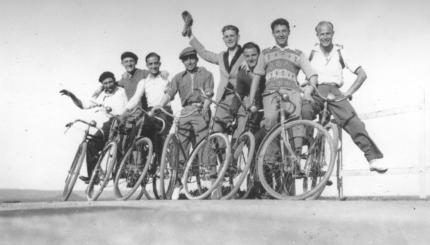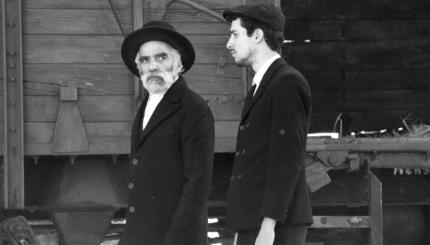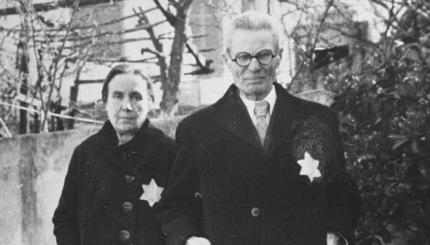“Turn it, turn it, for everything is in it…” say our sages about the Torah. From rabbinic times forward, we have stories and commentaries that record the rabbis’ explorations of and reactions to sacred texts. Termed midrash (investigation, searching out), these teachings, a form of art in themselves, turn the text inside out, exploring all of its nuances and commenting on its meaning by answering unanswered questions found in the text.
Midrash is a literary genre that uses allegory and imaginative narrative to fill in those places in the text where the stories do not feel complete. In the last several decades, many artists, clergy, educators, and scholars have been creating what they refer to as “contemporary midrash.” Their work uses the process of investigating biblical and other scared texts to draw out meaning for people today; to re-animate biblical stories and characters and to add contemporary voices, visions, and concerns to the legacy of commentary.
Unlike classical midrash, which is a purely literary form, contemporary midrash takes many forms, including dance, drama, literature, theater, and the visual arts. Because the visual arts have not always been widely embraced by Jewish religious culture, contemporary fine artists working in this genre are often charting new territory in using visual images to comment on sacred texts.
Unique Artists, Unique Styles
Visual midrash can be found in a number of contemporary places: displayed in Jewish art galleries and museums, illustrating Jewish books, and sometimes as part of a lesson in a Jewish school or adult-education program. This movement to integrate visual imagery into a dialogue about our texts and our reactions to them is a deliberate attempt to recognize the power of art to combine our emotional, intellectual, and spiritual understandings of text.
An example is the work of artist Archie Rand. Rand’s expressive paintings depict biblical characters–such as Eve, Moses, and King David–in comic-book style frames, with Hebrew text written in cartoon balloons and boxes. He creates a new visual language that integrates pop-culture sensibility with serious investigation of biblical dilemmas, challenging the viewer to imagine how these ancient texts relate to our own moral and spiritual predicaments.
Rand’s biblical characters appear in modern dress, and his juxtaposition of contemporary and ancient symbols forces the viewer to think about biblical text in a metaphorical manner. One of his paintings, for example, quotes from Genesis, “And the man gave names to all the cattle and to the birds of the sky, and to every beast of the field, but for Adam no fitting helper was found for him”; it portrays Eve wandering in a barren land, surrounded by dinosaurs.
Another artist creating visual midrash is Tobi Kahn. A painter and sculptor, much of Kahn’s work has explored Jewish religion and identity, some of which comments on biblical texts. Kahn says of his work: “Although Judaism has emphasized words, language, and interpretation, I have found the visual elements of the tradition equally illuminating. For me, the life of the spirit is integrally bound up with the beauty of the world, with the rituals and symbols that are a Jewish medium to transcendence. Like language, what we see can be a benediction.
A 2003 exhibit at the Yeshiva University Museum called “Microcosmos” featured a series of Kahn’s abstract paintings inspired by the first chapter in the Book of Genesis. Evocative of the cosmos and elements of the earth, Kahn interprets Genesis in a meditative, minimalist series that invites the viewer to think about his or her own place in the vastness of creation. His paintings are metaphors for creation, examining the simplicity and beauty that begins with each a single cell.
|
|
|
“Crossroads,” a 1988 midrashic work by Renata Stein, is a depiction of the Torah portion Lekh-L’kha (Genesis 12:1-17:27). Its central figure is Sarah, with Abraham and Hagar in the sidelines. Image courtesy the artist. |
Adding Women’s Voices
As best we know, the sages who created our classical midrashwere all male and many of their commentaries reflect an understandably male-centric view. In many cases, it is only in the last 50 or so years that Jewish women have been given equal opportunities to learning sacred texts, and many have started to create commentaries of their own. A number of prominent female fine artists and sculptors have added their voices and visions to the midrashic process by creating contemporary work commenting on the Bible.
Suzanne Benton is a sculptor, mask performer, and print maker who has traveled the world exploring myth, ritual, and archetypes in many cultures. Her mask-making series includes one of Jewish women from the Hebrew Bible, including the matriarch Sarah and her handmaiden Hagar. Benton is both a visual and performing artist, using her mask performances to examine the complex tale of these women and their struggles around fertility and motherhood. Benton has taken this performance to countries around the world, using this particular biblical story to explore universal issues.
Renata Stein is an artist who works in mixed media, especially using everyday found objects to create a new visual language the reflects images of ordinary life. Her midrashic works include mixed media art commenting on the stories of the Akedah (Binding of Isaac), Leah and Rachel, and Jacob’s ladder. Using stones, branches and other found materials takes her work out of the literal realm and into the symbolic one, which opens the viewer to his or her own imaginings about the stories.
One of Stein’s mixed media pieces, called “Jacob Set up a Pillar (Tree of Life),”recalls the moment in Genesis when Jacob–fleeing from his brother, Esau–stops in a new place to rest and sets up a pillar, before having his auspicious dream of angels climbing up and down a ladder from heaven. Stein’s envisioning of the pillar is a mixed-media piece that uses found objects to create a tree with branches stretching toward heaven and roots dangling down toward earth.
Artist Ruth Weisberg’s drawings can be found in The Open Door, a New Haggadah, edited by Rabbi Sue Levi Elwell (CCAR Press). The book that accompanies and guides Jews through the order of the Passover seder, Haggadot have been illustrated at least as far back as the Middle Ages. Weisberg depicts humanistic, figurative images that reflect the Open Door Haggadah’s sensitivity to gender-inclusive language. Her rendering of the story of the Exodus from Egypt includes aspects of the story that have not always been emphasized before, including the bravery of the midwives Shifra and Puah. Her midrash is an example of how art can affect ritual and prayer, in this case aiming to deepen the spiritual experience of the seder.
Artist Beth Grossman has taken the idea of exploring biblical texts into a new direction; her work is about recontextualizing history and mythology–creating art that can turn assumptions upside down. While studying art in Italy, she found herself surrounded by images of an idealized, iconic Mary–the virgin mother. That experience, along with her interest in interfaith dialogue, inspired Grossman to explore the Jewish roots of this Christian icon. Grossman chose to revisit Mary’s story and create art that portrays her as an unidealized, very human Jewish woman.
When her Mary works have been exhibited, she has invited both Jewish and Christian groups to view and discuss the meaning of her artwork. As an artist, she is interested in finding common threads among groups; in this case, she feels it is significant for both Jews and Christians to remember that Mary, Joseph, and Jesus were known, historically, to be Jewish.
Her piece “Mary of Abraham, Isaac and Jacob,” for example, features a painting of a modern-looking Mary shielding baby Jesus. Mary is wearing a yellow star, as if she was a Jew in Nazi Germany. The painting is enclosed in a suitcase, filled with yellow stars. Written on the stars on the left side of the suitcase are stereotypes that the Nazis pinned on Jews, such as “greedy” and “useless.” The stars on the right are qualities traditionally attributed to Mary, who is also a Jew, such as “angelic” and “blessed.” The piece’s message or intention is to show the duality of human beings, how the same woman could have been worshipped or reviled simply by the time she lived in and the perceptions of those around her.
|
|
|
Beth Grossman’s “Mary of Abraham, Isaac and Jacob,” depicting the Mary and Jesus–both Jews–amidst Nazi-era yellow stars. Image courtesy the artist. |
Not Just for Professionals
Visual midrash is not a form of expression limited only to professional artists. Educators are recognizing the importance of using the visual arts in Jewish education and their value in enlivening biblical texts for students. Scholar and artist Jo Milgrom wrote the pioneering book Handmade Midrash (published in 1999), which offers simple, clear instructions for Jewish expression through the visual arts; it was embraced with enthusiasm by many Jewish educators. In classrooms and Torah study workshops, teachers started using Milgrom’s techniques to inspire students to express through art emotions and reactions to biblical stories. Recognizing the value of visual learning as one of many multiple intelligences, the visual arts–and contemporary midrash specifically–are gaining a mainstream place in the Jewish classroom.
Visual art offers a different way of thinking and knowing, and by adding visual midrash to our literary commentaries, we are turning sacred texts in new ways, with new language, creating new visions.
Torah
Pronunced: TORE-uh, Origin: Hebrew, the Five Books of Moses.




